THE NPC NATIONALS 2005
Women's Bodybuilding and Fitness
November 18th & 19th, Atlanta
GA
CONTEST REPORT
back
By Bill Dobbins
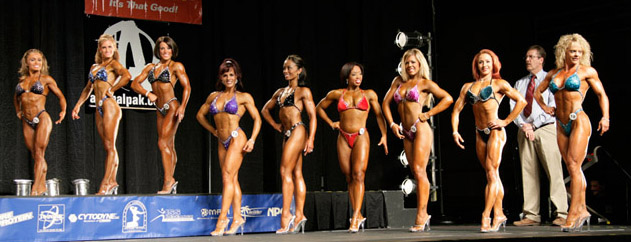
INTRODUCTION
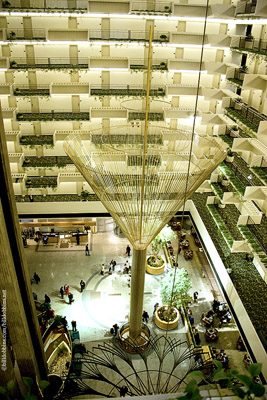 |
| At the Hyatt Regency, everyone can see who is coming in and out of your room. |
The 2005 NPC Nationals was a successful competition by
most standards. The contest
had a lot of good competitors, was well produced and sold a reasonable
amount of tickets. The"expo"
part of the event was somewhat limited which is somewhat surprising given
that this is the premier NPC contest of the entire year. But
this may simply be due to sponsors feeling that they get more bang for their
buck at the Olympia just a month earlier.
The Nationals was held at the Hyatt Regency Hotel (one
of those hotels where the doors to the rooms open directly onto a central
common space and everyone can see who is coming in and out – so the
transsexual hooker who knocks on your door better be delivering pizza!). Because the venue is a hotel ballroom, there is only flat seating
available, not sloped theatrical seating, which can make it more difficult
for people in the back to see. I'm
told there is a policy against this in the NPC regulations but promoters
need to make money to stay in business and this might have been just an economic
necessity.
In fact, I kept hearing from NPC promoters that many were
concerned with a steady decline in ticket sales over the years. Amateur bodybuilding is alive but in
some cases not doing all that well financially. I'm convinced that one reason for this is that neither the
NPC nor the IFBB makes use of professional public relations to help publicize
and promote the sport. While
bodybuilding had a much improved image in the 1980s and early 1990s, this
is not the case today. Joe Weider
has retired, Arnold has been accused of conflict of interest because of his
involvement with Weider Publications and there is nobody out there to look
out for the interests of bodybuilding on a national level. This coupled with the NPC policy of not
giving press credentials to any websites (including bodybuilding.com, a major
sponsor) no doubt has a lot to do with the situation about which the promoters
are concerned.
FEMALE BODYBUILDING
We have always seen a dearth of female bodybuilders at
the local level in NPC shows. There
just aren't enough of them coming up to fill up the pipeline. This has been made worse by the fact
that so many women have been abandoning bodybuilding for figure competition. This
move is almost always futile since – especially at the higher levels – the
women winning figure are genetically very different from those who are good
bodybuilders. But there has
been so much negative publicity regarding bodybuilding for women that some
competitors continue to make the switch and then generally end up quitting
altogether when they realize figure is a dead end for them.
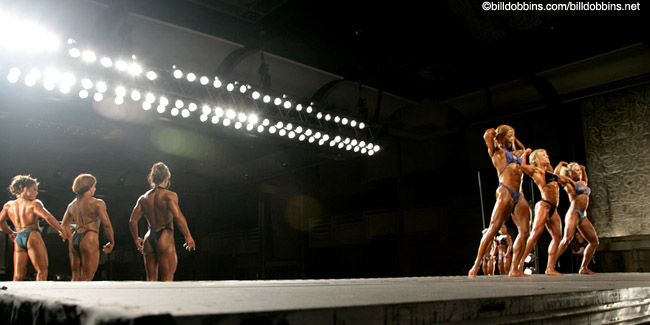
But this year's Nationals had 68 female bodybuilders entered,
which is a good sign. Not only
were there 68 women competing in four weight divisions but many noticed how
many really attractive female bodybuilders they saw in the line-up. Bodybuilding is not a beauty contest,
but in terms of overall appeal and the ability to get positive publicity
having an attractive face and an aesthetic face has always been an advantage –
for the men, as well as the women.
NPC women's bodybuilding is held using four weight divisions
which is as it should be. The
IFBB had been holding women's bodybuilding events using only two weight divisions
(usually – sometimes but rarely three) but has gone back to having
all the women
compete in one class as do the men. Using this approach, the bigger competitors have too much
of an advantage, the smaller ones tend to try and gain too much unaesthetic
size and smaller amateurs are discouraged from competing as pros. Bodybuilding is supposed to be about
perfection – not mass and size.
You can read details of how each class was judged from
a variety of sources (for example, graphicmuscle.com and ftvideo.com). My main impression of the contest and
the judging is the NPC seems intent on rewarding amateur women bodybuilders
who are good but not"extreme" in the sense that they would quickly become
competitive in the pros. In
other words, the NPC ends up giving pro cards to female bodybuilders who
will not be able to make good use of them – and least, not in the short
term.
Of course, given that there are no weight divisions in
the IFBB pro competitions, it would be rare to find lightweight and middleweight
amateur women who could make any impact in the pros. For that, you'd need a physique as extraordinary as Juliette
Bergmann (who only came back to the IFBB when weight divisions were announced)
or Dayana Cadeau (whose Flex Wheeler-like muscle shape on a 135 pound physique
has resulted in most of the physique magazines declaring she is"too big"
to feature in photos).
The lightweight champion was Carla Salatti, already a two-time
winner in 2005. Runner up was
Jamie Troxel, a former powerlifter with a lot of solid, dense muscle mass.
In the middleweight division, the winner was Norma Nieves,
who had competed in 2004 as a light-heavyweight – a perfect example
of how bodybuilding is more about perfection than mass and that weight divisions
encourage bodybuilders to find the weight at which they actually look their
best. Ellen Woodley was second and Lindsay Mulinazzi was third –
and watching the three of them on stage was clear evidence that bodybuilding
for women might be having problems but excellent women bodybuilders themselves
are doing fine.
The real controversy involving women's bodybuilding at
the Nationals concerned the light-heavyweights. In 2000, the"guidelines" issues by the IFBB and adopted by
the NPC created havoc in the judging results in both federations. One example is the 2000
USA. Debi Lazsweski (pronounced"la-chef-ski")
was in the eyes of many (including one judge I spoke to afterwards) the clear
winner. But because she was"too big" according to the standards of the"guidelines" she was relegated
to 7th in her class. Unfortunately,
this unjust and unfair outcome discouraged Debi to the point where she stayed
out of competition until this year. But
she entered the 2005 Nationals in the hope that the judging would be more
accurate this year.
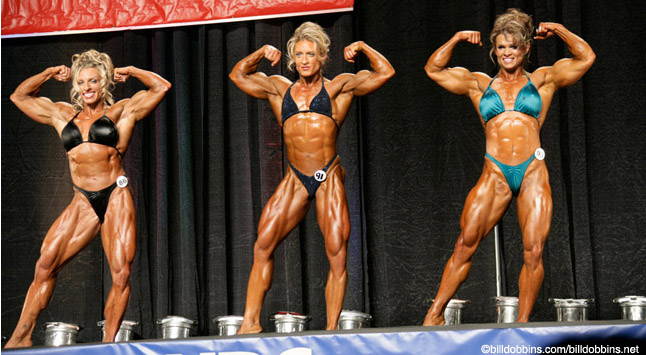 |
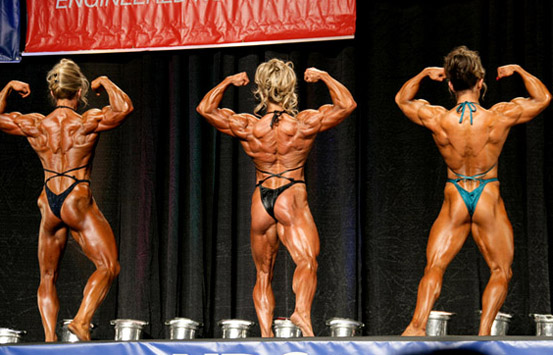 |
||||||
|
|
But it wasn't. You
can usually tell who is going to place where in a contest head-judged by
Sandy Ranalli. As I've described in other reports, the
first five competitors Sandy calls out are almost always the top five finishers
in the contest (and women not in that group never get to be compared with
anyone who is). Then Sandy rearranges
them so that the probable winner is in the center, the second and third finishers
next to her and so on. So while there is an occasional surprise at the outcome,
it is usually fairly predictable.
But this wasn't the procedure used with the light-heavyweights. Debi,
Dena Westerfield and Elena Seiple were
compared as a group – more than once – and Sandy kept rearranging
them with first one in the center, then the other, then the other. It was clear the judges were having a
problem. Both Dena and
Elena looked terrific, no doubt out it – but they looked like really
excellent amateurs standing next to a pro. Debi
could have walked out of that auditorium and across the street to an IFBB
pro contest and done very well, In
fact, Debi Leszewski was the ONLY female bodybuilder among the 68 entered
about whom that could be said. Nonetheless,
Debi ended up getting only two first place votes out of 11 judges and two
of the officials had her third!
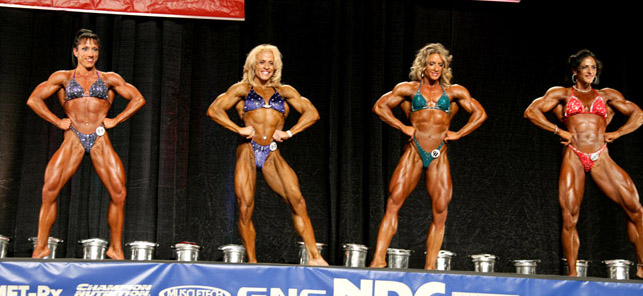 |
||||
|
What this seems to mean is that, as happened in 2000, NPC
judges are interpreting the idea of being"too big" not as"too big for her
frame" or"too big and bulky and lacking aesthetics" but instead as"too
big for the line-up!" Using
this as a criteria, Ms. Olympia Yaxeni Oriquen wouldn't stand a chance in
the NPC. What this means is that the NPC is judging
by a set of standards that guarantees the best potential pros in the federation
will not be able to earn their pro cards.
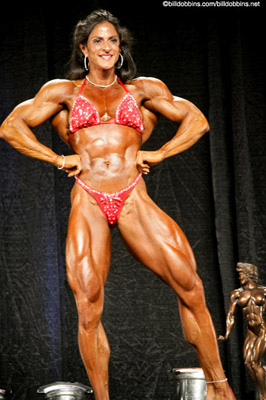 |
Mimi Jabalee - Overall Winner |
The heavyweight class was yet another example of how good
the NPC women bodybuilders looked this year as a group - even if not of the
caliber that could easily step up to the pros and be immediate successes. Mimi Jabalee was a popular winner of the class with Texan
Jody May placing second. By
the way, talking about pro potential there may not be a female bodybuilder
in the whole NPC with more potential to win a top contest like the Ms. Olympia
than big, beautiful Jody – IF she were ever able to develop to the
limits of that potential. Unfortunately,
to hear her describe her own attitude toward the sport it seems she might
be too easy going and lacking in ambition to develop the focus and determination
that achieving such a lofted goal involves.
All the class winners got pro cards, Mimi Jabalee won the
overall. Mimi certainly has
a future in the IFBB if she continues to work hard (after all, after a disappointing
first foray into the pro ranks last year's Nationals winner Bonny Priest
placed 6th at the Ms. Olympia 2005). But if the correct and traditional standards
of bodybuilding had been applied to the judging, Mimi still would have won
her class but I have no doubt that the overall winner would have been Debi
Leszewski. Let's hope this second
brutal and undeserved unfairness won't prevent Debi from continuing her quest
to win an NPC championship. But
you could hardly blame her if it did.
The story of the 2005 Fitness Nationals was apparent in the routines. There were some very good ones but no super-routines, the kind we have been use to seeing from competitors like Susan Curray or Kelly Ryan. I've been pointing out for years that the rules have cut off the"new blood" in NPC fitness (example: a stage full of figure competitors at the NPC California Championships and TWO women entered in fitness).
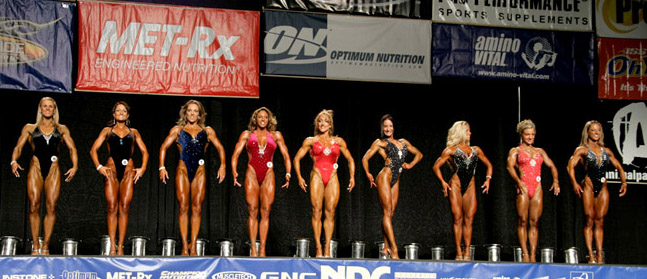
Fitness was adopted by the NPC in response to the Ms. Fitness
events and then the Fitness America. Both of those events put a lot of emphasis on the routine,
and much of those routines consist of gymnastics. But Wally Boyco and Lou Zwick who control those competitions
are basically holding them in order to create television show, not to
sell tickets to a live audience. But selling tickets in what it takes
to promote NPC contests and fitness takes up a lot of time and because of
the physical dangers involve opens up a can of worms as far as liability
is concerned (such as doing gymnastics without the aid of a gymnastics mat).
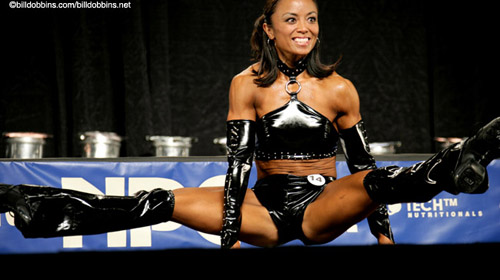 |
The fitness routine was invented
first to entertain participants in Expos and then used to fill up an hour on TV. Because of the priority on gymnastics, many women are choosing figure instead. |
So perhaps the federation is just letting this type of
competition die a natural death. The
Figure Nationals is held in New York and the USA now includes figure rather
than fitness. It's great for
the federation – many more women entering the events, paying fees to
the NPC and the promoter, just two rounds of quarter turns in different kinds
of suits, women with tall, leggy"model" proportions rather than more compact
gymnastics bodies, nobody likely to get hurt.
That being said, there were some impressive women in the
Fitness Nationals. The very
first competitor on stage in the short class was Heidi Fletcher, a very Monica
Brant-like blond firecracker who got my attention as well as Iron Man publisher
John Balik (who made sure I had Heidi's contact info).
Heidi ended up winning the overall against medium class
winner Tami Ough and tall class champion Jennifer Cassetty. A good contest, lots of attractive and
energetic young women. If you
missed it, too bad – there might not be a lot of them ahead in the
future the way things are going with NPC fitness.
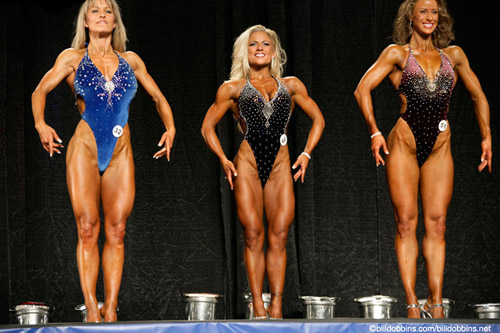 |
|||
|